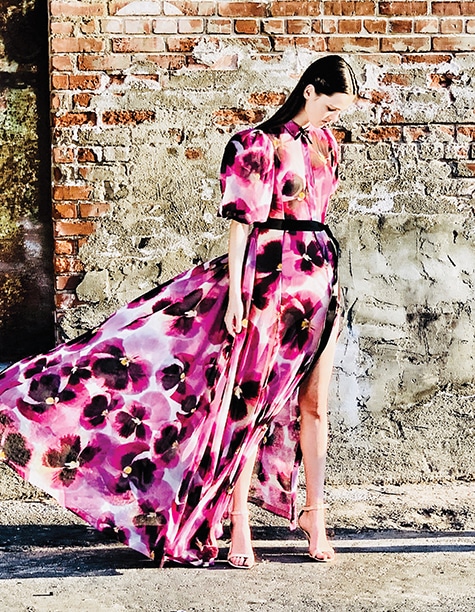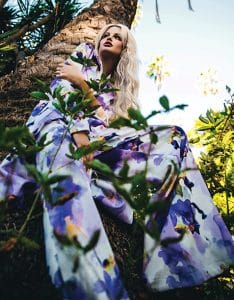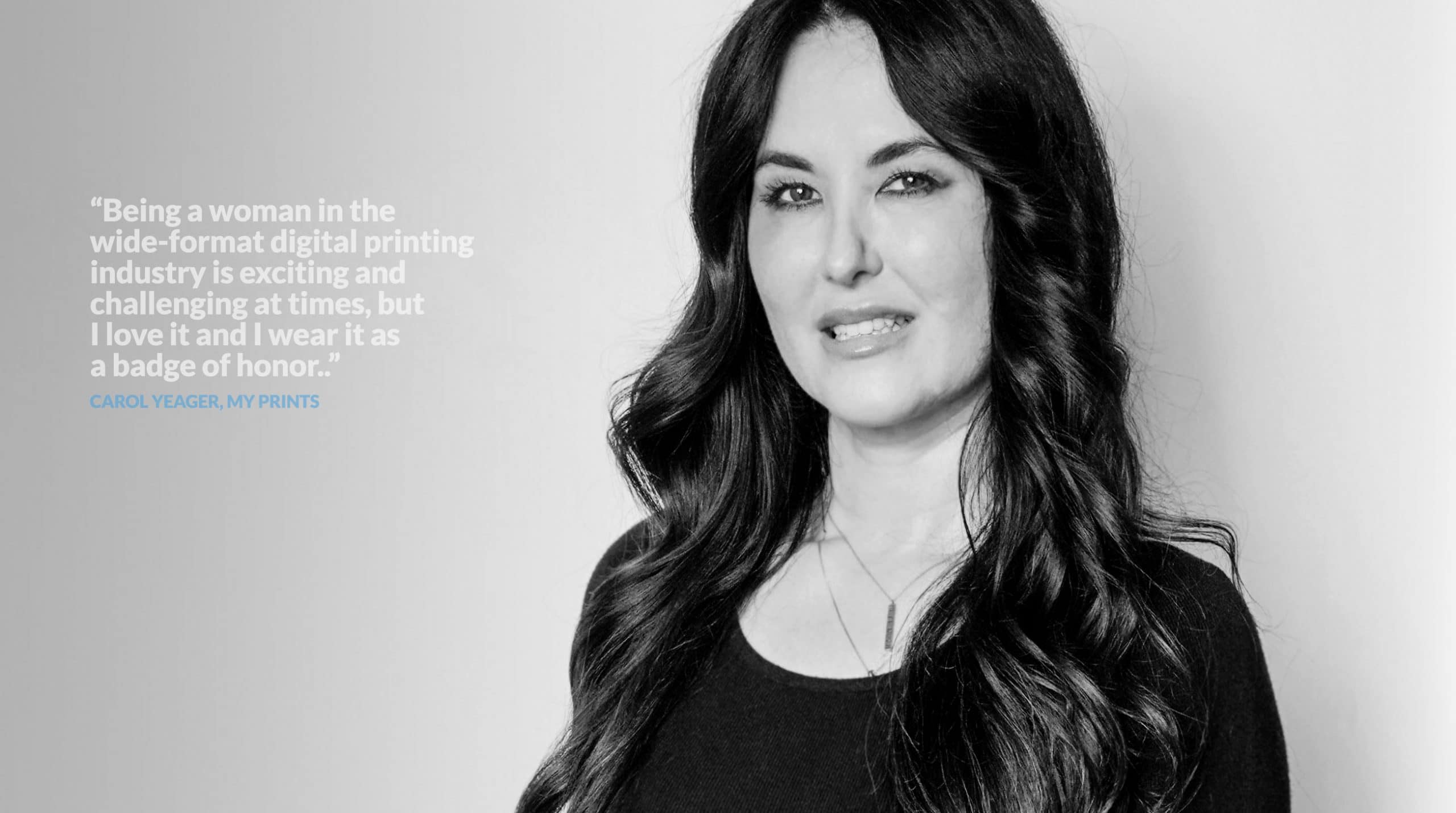Carol Yeager
Owner-Creative Director, MY Prints, Los Angeles
“She has the ability to pull the best out of people and will do anything in her power to help you achieve your dream. She always looks for ways to create new opportunities for women and has already built an impressive network of creative women around her. She’s done so much for this industry, often under the radar, and I know she’ll continue to help transition the fashion, art, and entertainment industries to thrive with digital printing technology. Carol bridges the gap between the technical and creative sides of digital printing and pushes the boundaries of client service and customization. Her mission is clear: to explore, expand, and innovate! I truly cannot wait to see what she does next.” Kathryn Sanders, founder/principal, Digital Bias
YOU’RE ALWAYS looking for ways to create new opportunities for women and have already built an impressive network of creative women around you at MY Prints. What does it mean to be a woman in the wide-format digital printing industry?
Being a woman in the wide-format digital printing industry is exciting and challenging at times, but I love it and I wear it as a badge of honor. I’m hoping to help break barriers and encourage other talented women to enter our innovative world. When I started my studio in 2011, there weren’t a lot of other woman working in the industry. I would walk tradeshows with my business partner, Steven Moreno, and could count the other women walking the shows on one hand. It was clear to me this field, at the time, was dominated prominently by men. There were even times when I was asked if I was at the right convention. I would politely say, “Yes, I belong here.”

Advertisement
I started my career as a designer outsourcing my digital printing needs to local shops. I did not know much about digital printing or the process, but as I was exposed more and more to the benefits of digitally printing my samples locally, I wanted to learn the process inside and out, which led me to opening my own studio. Steven was the local printer who introduced me to digital printing. He took the time to show me that I should not be intimated and that this could be an industry I could thrive in. I am happy to say he was right.
It has been such a wonderful journey working on so many amazing projects. From printing costumes for the TV/film industry to having my printed pieces walk down runway shows. What I love about this industry is there are so many categories this industry can service. I love mentoring and exposing up-and-coming designers to the power of digital printing and all the advanced technologies it has to offer. Over the years, students from the Fashion Institute of Design & Merchandising have visited our studio and I always do my best to work with the female students to help encourage and broaden their scope in this industry. I think women and men collaborating brings so much to the table. What was once a male-dominated industry is now being peppered with inspiring and talented women who will continue to change the face of this industry. I am honored and proud to be one of the women awarded the Women in Wide Format Award this year. I will continue to be a voice in this industry and push boundaries.

You are an advocate for digital textile printing technology, and have exposed countless fashion designers, set designers, and interior designers to the power and potential of digital textile printing. Why is making large-format digital printing accessible and exciting to everyone so important to you?
My experience and exposure in the printing world began when I became a fabric merchandiser for a large textile converting company in Los Angeles. Around 2005, I was introduced to the traditional printing methods when visiting print mills in Korea and China. Wet printing on flatbeds and rotary were the norm, and that’s how I produced my prints. While traditional methods garnered nice, quality prints, there were some limitations I noticed right away. Artwork had to be simplified in order to be engraved, which made them look flatter and lose dimension. There were also limits to how many colors could be used in the prints, so I felt very restricted and could not push my designs as far as I wanted them to go. It was also an expensive process to have screens cut for each print, so there was pressure from the mills to get as much production use out of them as possible. Timing was also a big issue. Getting sample yardage imported from China or Korea took anywhere from three to six weeks. It was hard to react quickly to market trends when my source of sampling was being imported in and it would take many months to complete collections. What impacted me the most above all the other limitations I saw in traditional printing methods was the amount of waste byproduct from the process! Traditional printing creates a lot of waste in water and uses so much energy. At that time, these printing methods were what was available to me, but I always thought there must be a better, faster, more sustainable, and cost-effective way.
Then I was introduced to large-format digital printing. It was a game changer for me. I started working with a local digital printer who opened my eyes to a new world of printing. With digital printing, there were no boundaries or restrictions to designing and executing prints. No limits in repeat sizing and use of colors. Digital printing opened doors to short-run customizations that didn’t cost an arm and a leg. I could test prints with less worry about production commitments and I could be more experimental. I could have samples printed within days of conception and a collection could come to life in the fraction of the time. What I loved the most about digital printing was that it was also a more sustainable method. It uses less water and less energy while garnering higher quality results. The digital printing technology was revolutionizing the printing process and I became a huge fan and advocate.
Advertisement
Large-format digital printing was checking off so many things I was missing from traditional printing and I knew this was the world I belong in. From that point on, I loved nothing more than showing all my clients and other designers a better and more sustainable way to print. In 2011, I opened my digital printing studio, MY Prints in downtown Los Angeles with my partner, Steven Moreno, to showcase this method of printing. We are blessed to service the fashion, interior, and TV/film industry in a printing process we believe is far superior, while still being environmentally conscious.

Your print designs in collaboration with Fernando Alberto Atelier have made the covers of British Vogue, Vogue Italia, Vogue Spain, Harper's Bazar, and California Apparel News. You have designed pieces for New York Fashion Week and LA Fashion Week, as well as a swimwear collection for Epson. What is the biggest challenge you face when creating and printing high-end pieces?
The challenges I faced when I first started working on high-end collections was that I had to use primarily polyester fabrics for the dye sublimation process. Polyesters did not have the best reputation in the market and were considered a lesser, cheaper fabric than natural fibers like silk, cotton, and rayon. Natural fibers were always preferred by high-end designers, but over the years, the development of high-quality polyesters for both fashion and interior categories have entered the market and started to change the perspective of retailers, designers, and customers alike. Polyester fabrics garner such high-quality printing that soon the fact that the fabric was polyester became less and less important. It became less about fabric content and more about the hand, the drape, the prints, and vibrancy of the colors. Soon, samples made with printed polyester hung next to silks with little difference in look and feel. A silk dress can cost you $50 to $100 to have dried cleaned with risk of damage and shrinkage, while a dress made in polyester has much more durability and can be cleaned at home with little risk to the garment. I also love that recycled polyester fabrics are being developed more and more and adding to the sustainable value of digital printing on recycled polyesters.

When Fernando Alberto and I started working together on his collections in 2017, he too had some reservations about using polyester fabrics. He was accustomed to working with silks and would spend anywhere from $25 to $50 per yard. He would need hundreds of yards of fabric to complete his collections, which became a very costly affair. Once we started to work together in my studio, I would show him polyester fabrics that mimic silks, but was a fraction of the price. We were free to experiment without breaking the bank. Digitally printing onto polyesters fabrics allowed us to avoid buying expensive fabrics and having leftover waste. We printed exactly what we needed and if we needed more, it was as easy as a hit of a button. He became hooked on digital printing and the use of high-quality polyester fabrics like I was.
Advertisement
Our collaboration together on his collections have gotten a lot of press. Our pieces are requested by countless stylists for magazine shoots all over the world and, at times, our garments take a beating. A model may need to be submerged in water to capture a certain look or mood of the shoot. If we were working with silks, that garment would be permanently damaged and could not recover. Because we choose to work with digitally printed polyester fabrics, the piece is durable and can be used for multiple shoots and get much more mileage and play. Long gone are the days of itchy, sweat-inducing polyester fabrics of the ̕70s. A new era of nicely developed polyesters has entered our market and become my go-to quality. I will keep championing digitally printed high-quality polyester fabrics to anyone who will listen and try.


 Best of Wide Format2 months ago
Best of Wide Format2 months ago
 Best of Wide Format2 months ago
Best of Wide Format2 months ago
 Columns2 months ago
Columns2 months ago
 Blue Print2 weeks ago
Blue Print2 weeks ago
 Best of Wide Format2 months ago
Best of Wide Format2 months ago
 Best of Wide Format2 months ago
Best of Wide Format2 months ago
 Best of Wide Format2 months ago
Best of Wide Format2 months ago
 Best of Wide Format2 months ago
Best of Wide Format2 months ago
























